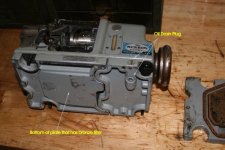Jason H
Stainless
- Joined
- Mar 29, 2006
- Location
- Los Angeles, CA.
I have a type of sewing machine that is used in several of my automated setups that is having cooling issues. This is a machine far from your typical as it is cam driven. I need some ideas as to how to increase its oil capacity, or provide better cooling, with the least amount of hassle. From the pics attached, please see the bottom two plates that are aluminum castings.
How can I adapt a sump type setup to provide a larger capacity of oil, or has anyone ever had experience with a CPU cooler like this one? I thought amount milling out a part of the machine and pressing ( screwing, or adhering ) in the cooling plate.
https://www.surpluscenter.com/item.asp?UID=2228011911514401&item=16-1361&catname=
Are there any type of car ATF coolers that might work? The machines have 220V 3P going to them as well as compressed air with monstrous amounts of volume to spare.
The maker of the machine has been consulted and they used to cast bottom plates with a bigger bubble, but they cant do it anymore since they off shored everything. ( another sad story ). The Al heatsink shown is made from the scrap bin. It did not help.
Thanks
Jason
How can I adapt a sump type setup to provide a larger capacity of oil, or has anyone ever had experience with a CPU cooler like this one? I thought amount milling out a part of the machine and pressing ( screwing, or adhering ) in the cooling plate.
https://www.surpluscenter.com/item.asp?UID=2228011911514401&item=16-1361&catname=
Are there any type of car ATF coolers that might work? The machines have 220V 3P going to them as well as compressed air with monstrous amounts of volume to spare.
The maker of the machine has been consulted and they used to cast bottom plates with a bigger bubble, but they cant do it anymore since they off shored everything. ( another sad story ). The Al heatsink shown is made from the scrap bin. It did not help.
Thanks
Jason






